RGD-5
The RGD-5 (Ruchnaya Granata Distantsionnaya, English "Hand Grenade Remote"), is a post–World War II Soviet anti-personnel fragmentation grenade, designed in the early 1950s. The RGD-5 was accepted to service in 1954. It is still in service with many of Russia's former client states and has been supplied to Iraq as well as other Arab nations.
| RGD-5 | |
|---|---|
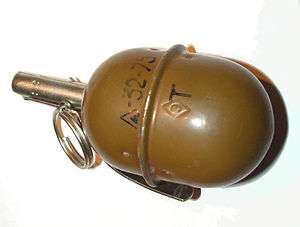 RGD-5 hand grenade with UZRGM fuze fitted | |
| Type | Hand grenade |
| Place of origin | |
| Service history | |
| In service | 1954–present |
| Wars | Vietnam War Six-Day War Yom Kippur War Soviet–Afghan War Iran–Iraq War Invasion of Kuwait First Chechen War Second Chechen War Iraq War 2008 South Ossetia War 2011 Libyan Civil War Syrian Civil War War in Donbass |
| Specifications | |
| Mass | 310 g |
| Length | 114 mm |
| Diameter | 58 mm |
| Effective firing range | 15–20 meters |
| Maximum firing range | 30 meters |
| Filling | Trinitrotoluene |
| Filling weight | 110 g |
Detonation mechanism | 3.2 to 4.2 seconds. pyrotechnic delay fuse |
Description
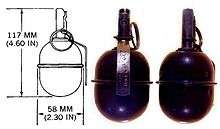
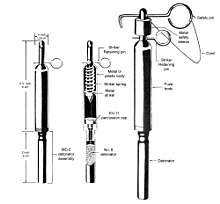
The grenade is egg-shaped with no external ribbing, except for a lateral ridge where the two halves of the grenade join. It weighs 310 grams (11 oz). It is 117 millimetres (4.6 in) in length and 58 millimetres (2.3 in) in diameter. The surface has a few small dimples on it with a green or olive drab paint-scheme.
The grenade contains a 110-gram (3.9 oz) charge of TNT with an internal fragmentation liner that produces around 350 fragments and has a fatality radius of around 3 metres (9.8 ft)[1] and a wounding radius of 25 metres (82 ft).[2][3] Typically, the RGD-5 uses the 3.2 to 4.2 second delay UZRG, UZRGM, or UZRGM-2 fuze, a universal Russian type that is also used in the RG-41, RG-42, and F1 grenades.[4] The RGD-5 can be thrown about 35 to 45 metres (115 to 148 ft) by the average male soldier and, when throwing, the grenade will make a loud "crack" sound as its spoon falls out activating the fuze, cooking off the grenade.
This grenade is still manufactured in Russia with copies produced in Bulgaria, China (as the Type 59) and Georgia. Many millions of RGD-5s and its clones have been manufactured over the years and, although not as advanced as more modern grenades that are specifically designed to penetrate CRISAT standard body armour, the RGD-5 is still an effective and inexpensive weapon. A single RGD-5 grenade costs around $5 US, making it highly affordable during a major conflict when many grenades are sought.
The RGD-5 may also be fitted with the more modern DVM-78 fuze, or variants of the UZRGM with delays of between zero (i.e., instantaneous for use in booby traps) and 13 seconds. It is also possible to screw an MUV booby-trap firing device into the fuze well.
Variants
Rifle grenade
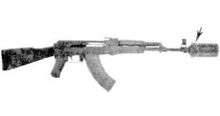
The AK-47 can mount a (rarely used) cup-type grenade-launcher that fires standard Soviet RGD-5 hand-grenades. The soup-can shaped launcher is screwed onto the AK-47’s muzzle.[5] It is prepared for firing by inserting a standard RGD-5 hand-grenade into the launcher, removing the safety pin, and inserting a special blank cartridge into the rifle's chamber. With the butt-stock of the rifle on the ground it can be fired.
The maximum effective range is approximately 150 metres (492 ft).[6]
URG-N
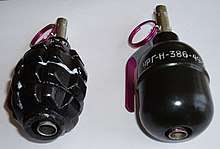
The URG-N is a reusable training model of the RGD-5 with a modified fuze containing a tiny explosive charge which simulates the detonation of the grenade. The body of this grenade is painted black with white markings.
China
- Type-59 - Chinese built variant.
Bulgaria
Poland
- RGO-88 - Polish variant with А-IX-1 filling (95% RDX and 5% Phlegmatized explosive). 60 grams of explosive mass.
Used in US President assassination attempt
_1.jpg)
On 10 May 2005, Vladimir Arutyunian, a Georgian citizen and ethnic Armenian, waited for the United States President George W. Bush and Georgian President Mikheil Saakashvili to speak in Tbilisi's central Liberty Square. When Bush began speaking, Arutyunian threw an RGD-5 hand grenade wrapped in a red plaid handkerchief toward the podium where Bush stood as he addressed the crowd. The grenade landed 18.6 metres (61 ft) from the podium, near where Saakashvili, his wife Sandra E. Roelofs, Laura Bush, and other officials were seated.[7]
The grenade failed to detonate. Although original reports indicated that the grenade was not live, it was later revealed that it was.[8] After Arutyunian pulled the pin and threw the grenade, it hit a girl, cushioning its impact. The red handkerchief remained wrapped around the grenade, and it prevented the striker lever from releasing. A Georgian security officer quickly removed the grenade, and Arutyunian disappeared.[7][9]
See also
- List of Russian weaponry
References
- Hogg, Ian V. (1991). Jane's Infantry Weapons 1991-92. Jane's Information Group. ISBN 0-7106-0963-9.
- "Russian RDG-5 grenades in both blasts". nationmultimedia.com. The Nation.
- "Archived copy". Archived from the original on 29 September 2007. Retrieved 9 December 2006.CS1 maint: archived copy as title (link) |RGD-5 data (in Russian)
- "HAND GRENADE RGD- 5". http://universal-dsg.com. Hartford International Group. External link in
|website=(help) - "Archived copy". Archived from the original on 2 February 2015. Retrieved 15 March 2014.CS1 maint: archived copy as title (link)
- File:AK47Figure54.jpg – Wikisource. En.wikisource.org. Retrieved on 2011-09-27.
- Operator's Manual for AK-47 Assault Rifle. Department of the Army
- "The Case of the Failed Hand Grenade Attack: Man Who Tried to Assassinate President Convicted Overseas". Federal Bureau of Investigation. 11 January 2006. Retrieved 6 December 2015.
- Terry Frieden (7 September 2005). "Alleged would-be Bush assassin indicted". CNN. Retrieved 22 March 2007.
- Nick Paton Walsh (19 May 2005). "FBI says hand grenade thrown at Bush was live". The Guardian. London. Retrieved 22 March 2007.